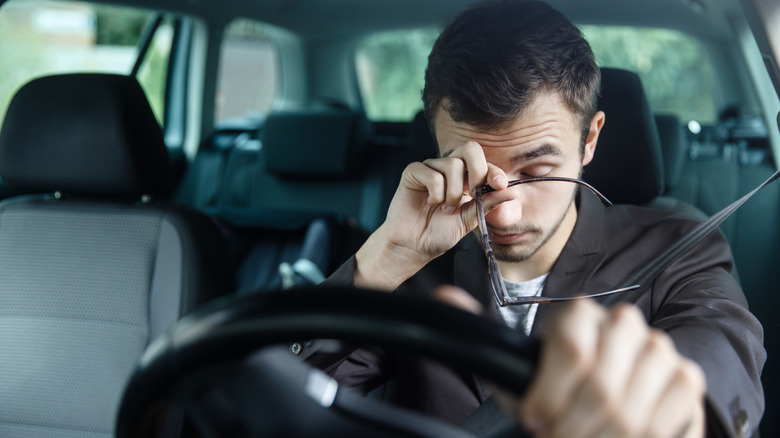Survey Shows A Vast Number Of Americans Are Drowsy Drivers
A poor night's sleep can leave you feeling tired and sluggish the next day. But the struggle to keep your eyes open after tossing and turning all night can potentially be fatal when getting behind the wheel. Even if you don't completely nod off, feeling drowsy can diminish your attentiveness while driving, reduce your reaction time, and affect your decision-making abilities, all of which can be dangerous if there's a sudden need to stop or swerve, reports the U.S. Centers for Disease Control and Prevention (CDC).
In an updated 2022 poll from the National Sleep Foundation, experts note that drowsy driving is estimated to be responsible for roughly 6,000 or more annual deaths across the country. The survey data revealed that 95% of people in the U.S. consider driving while drowsy to be "very" or "extremely" risky. However, when polling over 1,000 adults, 62% of drivers — equating to over 150 million adults — said that they've driven while sleepy to the point of struggling to keep their eyes open. When asked how often they engage in this behavior, 1 in 4 of these individuals said they drive while drowsy at least once a year. The survey also assessed which demographic groups were most affected by drowsy driving.
How to protect yourself against drowsy driving
Among those who reported driving while drowsy one or more times each year, men, those who self-identified as members of "other racial/ethnic groups," and those who had not graduated from college were among those shown to be at higher risk, as per the research. Commenting on these findings, the National Sleep Foundation highlights the role that health disparities may play among various demographic groups when it comes to sleep health (via HealthDay).
"We see that while most Americans believe drowsy driving is risky, they still drive when not fully alert. The good news is — drowsy driving is preventable," Joseph Dzierzewski, the vice president of research and scientific affairs at the National Sleep Foundation, told HealthDay. The National Highway Traffic Safety Administration (NHTSA) reports that most accidents related to drowsy driving occur in the late afternoon or in the middle of the night between 12 a.m. and 6 a.m. Crashes are also most likely to take place on rural roads or highways and often occur among motorists driving solo, the agency states. To help protect against accidents due to sleepiness, experts suggest avoiding driving during hours when the risk for drowsy driving-related crashes is highest and utilizing public transportation if you take medications known to cause drowsiness as a side effect. Most importantly, the CDC recommends that adults get at least seven hours of sleep per night in order to stay focused and alert during the day.


